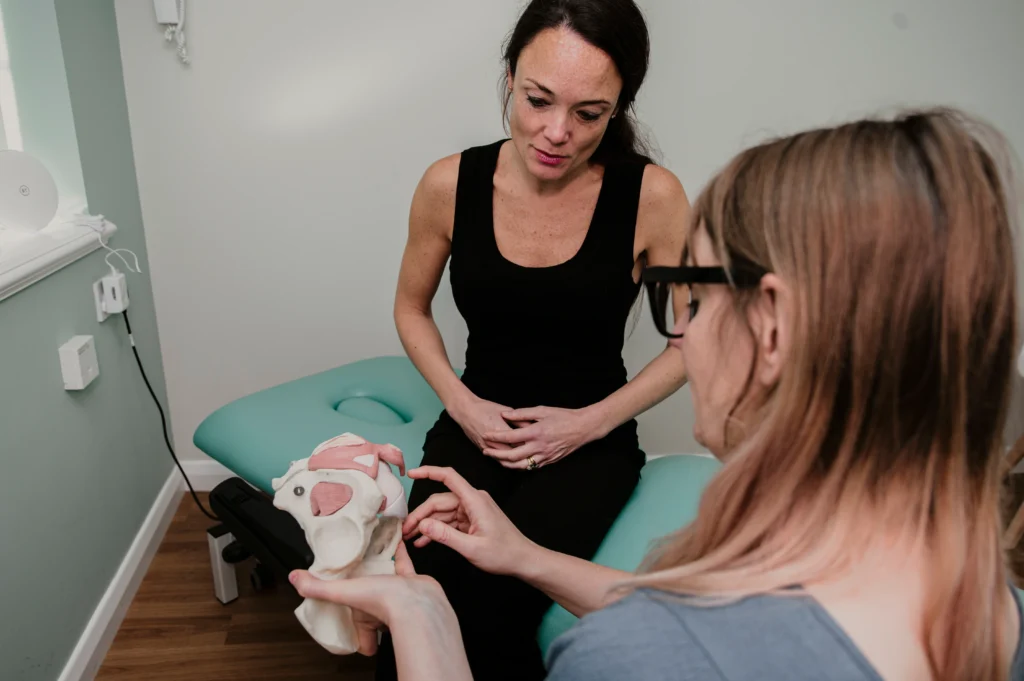
Do you feel as though your kegels aren’t working, but you’re not sure why?
If your kegels aren’t working, you may find you experience pain and bladder leaks. These are very common symptoms for many women. They are often a sign that the pelvic floor muscle isn’t working optimally.
If you visit your GP with these symptoms, you may be told to do kegel exercises in order to strengthen your pelvic floor. But, many of the women who visit our Physiotherapy clinics in Sheffield tell us they aren’t actually sure if they’re doing their squeezes correctly.
You may feel as though you’re squeezing your pelvic floor muscle a lot of the time to no avail. Or perhaps you are nervous to return to sports and activities you used to enjoy, for fear of leaks and pain.
Here are 3 possible reasons why your kegels aren’t working;
1. You’re doing them when lying down
Many women do their kegels when lying down, often at night when they’re in bed. But, like any muscle, the pelvic floor needs to be challenged!
Lying down enables a passive squeeze and doesn’t strengthen the pelvic floor muscle as much as it could. There are a few options to engage your pelvic floor muscle when doing your kegels;
- * Squeeze whilst in a sitting position
- * Do your kegels when standing
- * Squeeze the pelvic floor muscle when you’re about to sneeze or cough
These active squeezes will challenge the pelvic floor muscle. to engage in an active squeeze. If your kegels aren’t working, this may be because the muscles aren’t active enough. Consider your position and actions when you do your kegels.
2. You aren’t resting fully between squeezes
Like any muscle, the pelvic floor needs rest. Good, strong squeezes are ideal for engaging the muscles, but you must relax fully between squeezes.
When teaching patients how to do their kegels correctly, we usually suggest this process;
- Take a deep breath in
- Focus on your back passage
- On your out-breath, squeeze as if you’re trying to stop yourself from passing wind
- Then bring your attention to your vagina. Squeeze it deeply as if (and forgive us for this, but it always gets the best squeeze!) you’re in a bath full of eels and you don’t want one going up!
- Then squeeze as if you’re trying to stop yourself from passing urine mid-flow
- On your next in-breath, relax the squeeze completely and take a couple of seconds to rest.
- When you feel fully relaxed, repeat the sequence
Also, consider how many times a day you’re doing your kegels. A set of 5-10 squeezes, three times a day (morning, afternoon and night) is a good guideline. If you find you’re engaging your pelvic floor muscle multiple times throughout the day, or holding your muscles all the time, you may need to see a GP or Physiotherapist.
Roisin O’Bentley, Owner of Thrive Physiotherapy, explains;
“Many women who experience leaks end up holding their pelvic floor muscle a lot of the time. This tires out the muscle by making it work harder than it should. It’s very important to rest your pelvic floor muscle to avoid excess wear and tear. If your kegels aren’t working, this might be because they’re being overworked.”
3. Kegels alone aren’t enough
If you’re doing all of the above and still feel your kegels aren’t working, you may need extra help.
You can visit a GP or a Physiotherapist to get help and support. If possible, try to visit a GP or Physio that specialises in women’s health. This is because many doctors and Physios simply don’t have the deep knowledge of pelvic floor health to be able to provide the holistic support you may need.
Breathing, posture and exercise are all important alongside your kegels to ensure they’re effective.
Thrive Physiotherapy for women in Sheffield
At Thrive Physiotherapy, we help women in Sheffield overcome pain, leaks, prolapse, menopause symptoms and other issues. It’s our goal to help every woman live fearlessly, without pain or leaks.
We offer 1:1 consultations at our clinics in Sharrow Vale and Nether Edge. And we run Pelvic Strength Exercise Classes (in groups). The Pelvic Strength Exercise Classes run over the course of 8 weeks. You can register your interest for our next course by emailing hello@thrive-physiotherapy.co.uk.
Keep an eye on this blog for the latest news and information. Or follow us on Facebook, Instagram or Pinterest and sign up to our Newsletter!